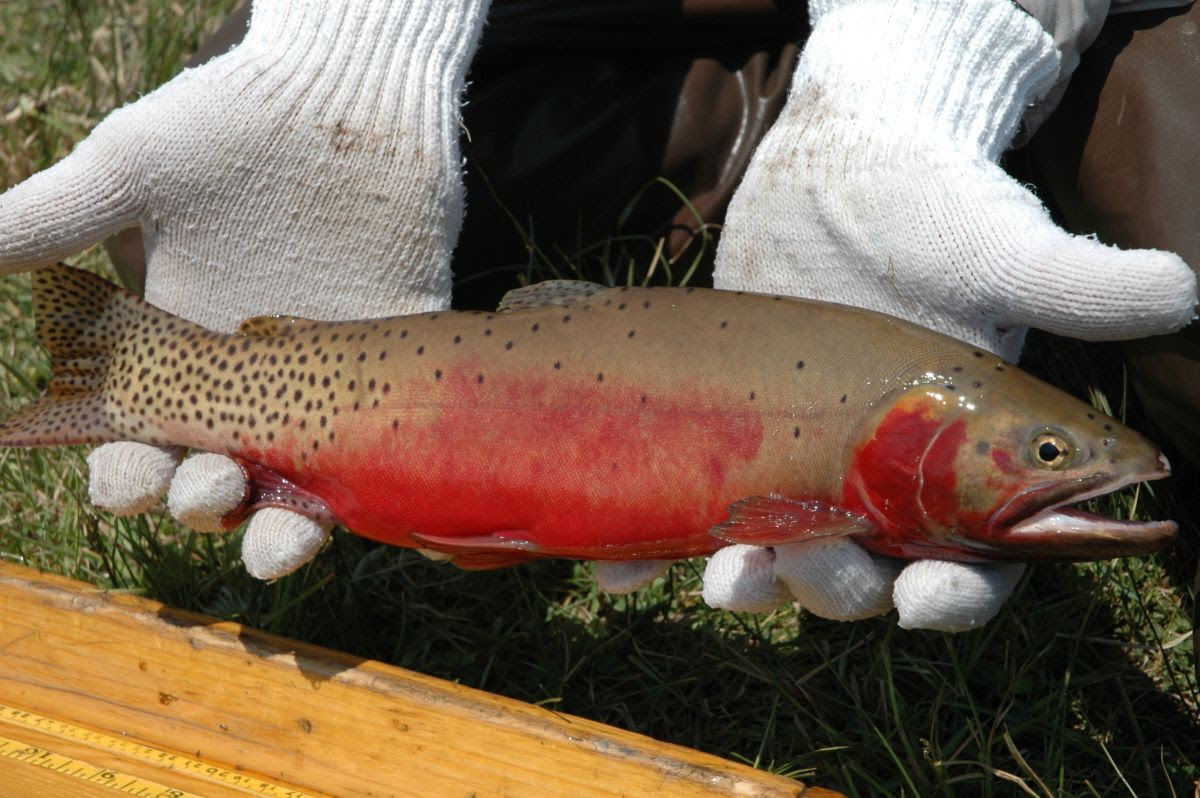Colorado Parks and Wildlife has identified a new home for a native fish.
Officials recently announced work would begin late this month to prepare Rito Hondo Reservoir for Rio Grande cutthroat trout. In a news release, CPW called it “a unique opportunity” while the reservoir near Creede has been lowered for dam repairs.
According to the release, the process will start with adding a piscicide called rotenone. The chemical is intended to kill off non-native brook trout — what CPW describes as “essential” to establish Rio Grande cutthroats.
The spotted, red-bellied fish indigenous to Colorado and New Mexico — the southernmost distribution of its range — has been the focus of a multi-agency strategy since 2003, when states, tribes and the federal government signed a formal agreement to help restore the species. Today, CPW reports the trout occupies 12% of its historic habitat.
Biologists blame the loss on drought, human development and complications from other, non-native species. Species such as brook trout “compete, prey on and/or readily hybridize with cutthroat trout,” CPW’s recent news release explained.
Success! Thank you for subscribing to our newsletter.
function subscribeSuccess() {
var nsltrform = document.querySelector(“#nsltr”);
var nsltrSuccess = document.querySelector(“#successnsltr”);
nsltrform.classList.add(“hideblock”);
nsltrSuccess.classList.remove(“hideblock”);
}
function validateEmail(email) {
return String(email)
.toLowerCase()
.match(
/^(([^()[]\.,;:s@”]+(.[^()[]\.,;:s@”]+)*)|(“.+”))@(([[0-9]{1,3}.[0-9]{1,3}.[0-9]{1,3}.[0-9]{1,3}])|(([a-zA-Z-0-9]+.)+[a-zA-Z]{2,}))$/
);
}
function validateEmailAddress() {
const result = document.querySelector(“#result”);
const email = document.querySelector(“#email”).value;
result.innerText = “”;
if(validateEmail(email)) {
newsletterSubscribe(email);
} else {
result.innerText = ‘The email entered: ‘ + email + ‘ is not valid :(‘;
result.style.color = “red”;
}
return false;
}
function newsletterSubscribe(email) {
fetch(“https://services.gazette.com/mg2-newsletters.php?action=subscribe&site=denvergazette.com&emailPreferenceId=60&email=” + email, {
method: “POST”
}).then(res => {
console.log(“SUCCESSFUL POST”);
subscribeSuccess();
});
}
#nsltr {
min-width: 100%;
margin: 10px 0;
padding: 10px 20px;
background-color: #2076b3;
background-image: url(https://static.gazette.com/emails/circ/Audience%20Images/dg%20outdoors%20sign%20up.png);
background-size: cover;
}
#nsltr-header {
color: #fff4f4;
}
#nsltr-body {
text-align: center;
color: ;
}
#nsltr-button {
margin-top: 5px;
}
#successnsltr {
min-width: 100%;
margin: 10px 0;
padding: 10px 20px;
background-color: green;
text-align: center;
color: white;
}
#successnsltr a {
color: white;
}
.hideblock {
display:none;
}
h6 a {
color: black;
text-decoration: none;
padding: 5px;
background-color: #bbccdd;
font-weight: 600;
}
@media only screen and (min-width: 768px) {
#nsltr {
background-image: url(https://static.gazette.com/emails/circ/Audience%20Images/dg%20outdoors%20sign%20up.png);
background-size: cover;
}
}
The goal is for Rito Hondo Reservoir to be fishless through winter. Officials anticipate the drained reservoir to refill following spring runoff in 2024. The water would then be stocked with Rio Grande cutthroats in the summer.
Agency biologist Estevan Vigil expressed confidence in a new trout population growing and spreading around the Rio Grande River.
“We anticipate this being a great conservation success,” Vigil said in the release. “We hope to establish this as a broodstock lake to get more Rio Grande cutthroat eggs for stocking out across the San Luis Valley.”
He indicated it could take three to five years for the trout to grow to large, catchable sizes.





